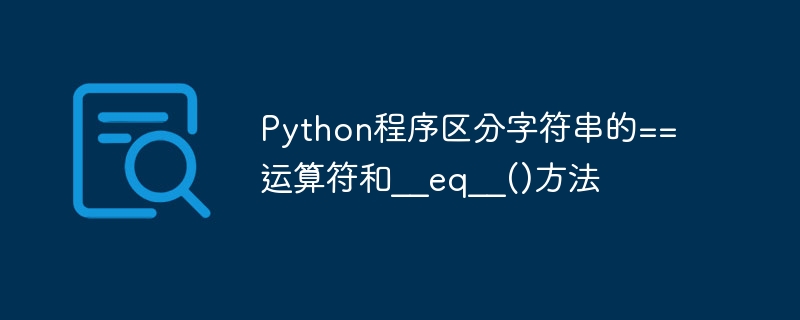Home >Backend Development >Python Tutorial >Python program distinguishes between string == operator and __eq__() method
Python program distinguishes between string == operator and __eq__() method
- WBOYWBOYWBOYWBOYWBOYWBOYWBOYWBOYWBOYWBOYWBOYWBOYWBforward
- 2023-09-22 15:13:021188browse

In Python, the comparison operator (==) and the equals() method are used in different ways when working with strings. To differentiate between the == operator and the equals method in Python, we have to use them with string comparisons. String comparison occurs widely when we use strings in data analysis and machine learning. In this article, we will learn how to differentiate between the == operator and the equals() method when used with strings.
== Operator
in Python== is a comparison operator used to compare two string values. Returns True when the string values are equal and False when the string values are not equal. It returns true even if the strings are stored in different memory locations. It only compares the string values for equality.
Example
In the following example, we define two string values str1 and str2 and initialize them with the same string value. When we compare the strings str1 and str2 using == operator, it returns true because the values of both strings are equal. p>
str1 = "Hello World"
str2 = "Hello World"
if str1 == str2:
print("The strings are equal.")
else:
print("The strings are not equal.")
Output
The strings are equal.
__eq__() method in Python
The __eq__ method in Python is used to define how to compare objects of a class for equality. The __eq__ method takes two parameters: self (the object on the left side of the == operator) and other (the object on the right side of the == operator). The __eq__ method always returns a Boolean value (True or False). If it returns something other than a Boolean value, a TypeError will result.
Example
In the following example, we create a class named Person which has two properties, name and age. Then, we define the __eq__() method in the class to compare the name and age properties of the person object. Finally, create two instances of the person class, p1 and p2, and compare them using the == operator.
class Person:
def __init__(self, name, age):
self.name = name
self.age = age
def __eq__(self, other):
if isinstance(other, Person):
return self.name == other.name and self.age == other.age
return False
p1 = Person("John", 30)
p2 = Person("John", 30)
if p1 == p2:
print("p1 and p2 are equal")
Output
p1 and p2 are equal
Difference between == and __eq__ methods
== Operator |
__eq__method |
|---|---|
== is the default behavior in python when comparing the values of two objects. |
__eq__ Methods need to be explicitly defined in the class. |
==operator can be used to compare objects of different data types. |
__eq__Methods can only compare objects of the same type |
It doesn’t have much flexibility for customization. |
__eq__Methods can be customized for specific types of comparisons. |
It cannot be inherited and should be explicitly defined for each class. |
__eq__ method can be inherited from the parent class. |
in conclusion
In this article, we discussed how the == operator and __eq__ method work in Python. The == operator compares strings without looking at the string's memory location. The __eq__ method is defined in the class and is used to compare two objects. The article also discusses the difference between the == operator and the __eq__ method.
The above is the detailed content of Python program distinguishes between string == operator and __eq__() method. For more information, please follow other related articles on the PHP Chinese website!

